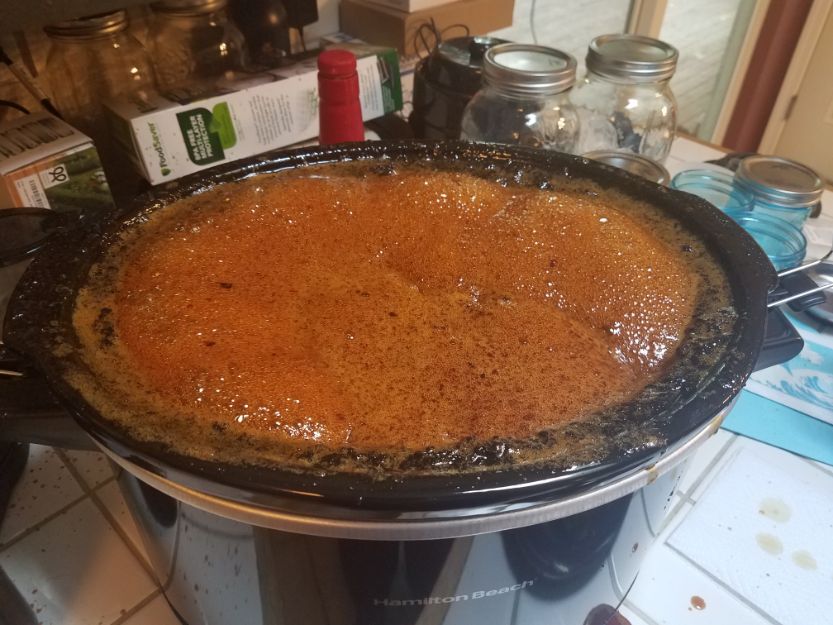Simplified steps to caramelize honey for making a Bochet style mead.
Originally Posted: Aug. 7, 2020

Table of Contents
Quick Specs
- OG = 1.105
- ABV: ~13.8%
- Taste Profile: Like caramel, toasted marshmallow, or toffee
- Time: ~3 months for the One-gallon version
- Size: One-gallon batch (scalable)
Intro
Bochet is a mead fermented from caramelized honey. It is darker than many meads, and the caramelization of the honey produces a lot of unfermentable sugars that add to its complexity. My first thought when I made a large 5-gallon batch (a bochet cyser) of it for the first time was that it looked as dark as a porter or stout.
This mead is the reason why I have a single caveat to my preference for the “No-Heat” method of meadmaking. For some reason that I haven’t pinned down yet, honey heated enough for caramelization to occur makes a mead that’s easily drinkable soon after bottling. I suppose if you were to graph mead with the honey’s max. temp. on the X-axis and drinkability on the Y-axis, you’d find a sort of “uncanny valley” between 100°F (38°C) and whatever temperature caramelization starts to occur at.
Brief History
According to a historical article focusing on bochet, modern homebrew attempts at making it were inspired by a 1393 book called “Le Menagier de Paris” (Laura Angotti, Mystery of Mead). However, the writer notes that there is a scarcity of historical information about making a mead specifically from caramelized honey. It may not have been a very common ingredient, but if that’s true then they were really missing out.
Ingredients
(Note: for One-gallon batch, can be scaled up):
- 3 lbs. of your choice of honey, caramelized
- 1-gallon water
- Yeast nutrient
- Yeast energizer (possibly, use your own judgment)
- Glucoamylase (optional, but useful for brews involving caramelization)

Equipment
- Sanitizer
- Fermenter
- Airlock and stopper
- Stock Pot for caramelization (optional), or:
- Slow Cooker for caramelization (optional, but easier than a stock pot)
- Stainless steel spoon
- Paper towel, to test level of browning
Instructions
First off, I’m going to mention that you can either caramelize the honey right before making the mead or you can make it ahead of time and store it. I like to caramelize batches of 5 lbs. of honey at a time in my 10-qt slow cooker and then store the honey in ½ gallon wide-mouth mason jars. I’ve tried doing this with 10 lbs. of honey in the same slow cooker, but honey expands A LOT when heated and I had a very sticky boil-over to clean up. I’ve found that 5 – 6 hours at low heat works great, or about 2 hours at high heat (though you need to be more attentive of the honey if you choose high heat).
You can also caramelize honey in a stock pot, but you really have to sit there and baby it. Constant stirring is necessary to prevent burns, and that burnt flavor will never age out of your mead. This was the way I made my first one-gallon batch of bochet, with 3 lbs. of honey.
Step-by-Step
- Caramelize your honey in whichever of the above methods you choose. Check caramelization periodically by using your stirring spoon to put a drop onto a clean paper towel. Taste periodically as well but take care not to burn yourself.
- Allow honey to cool, either by storing it for later or with an ice bath if you’re planning on making the mead right away. If you’re using previously caramelized honey, warm it up so it’s easier to get out of its container.
- Mix caramelized honey, water, and yeast nutrient with water, then add your choice of yeast. If you feel like some unfermentable sugars should be broken down, you can add glucoamylase any time during fermentation.

Variations
I’ve made a dark and tasty variant of my basic Cyser by using caramelized honey instead of raw honey. One thing I found with this Bochet Cyser is that the spices I used didn’t shine through as much as with the regular cyser. I suggest increasing the spices by 1.5-2 times for any spiced bochet and experimenting from there if you want the spices to shine through, or you can omit the spices altogether.

The dark color of my Bochet Cyser experiment also inspired me to make a Braggot Stout of about 8.3% ABV. This beer was delicious, but also so strong and heavy that I canned as much of it as I could so I could put something more sessionable on tap. Due to its high alcohol content, it was a prime candidate for cellaring.

Tips & Tricks
Might be useful to have some glucoamylase on hand to help break some of the complex unfermentable sugars into simpler fermentable ones. I suggest experimenting with this anytime caramelization is involved in a recipe.
Possible Culinary Uses
The best culinary use for this one that I’ve come across doesn’t even involve fermentation. The caramelized honey itself makes a good topping for ice cream or other desserts.




